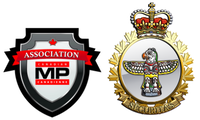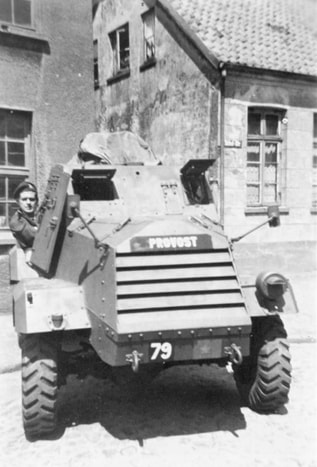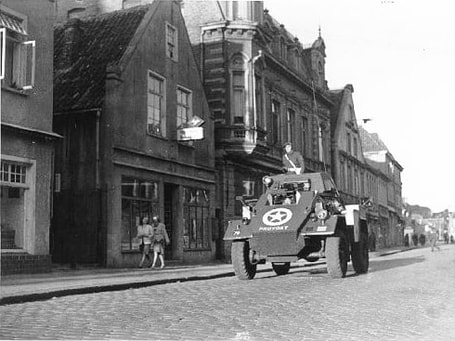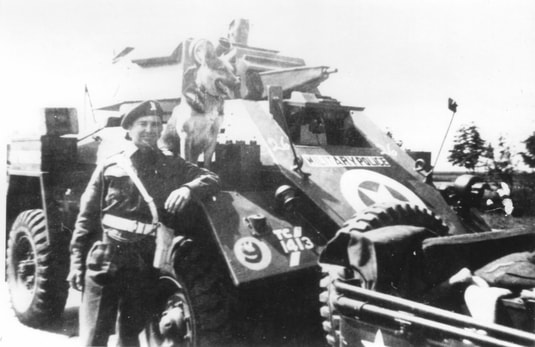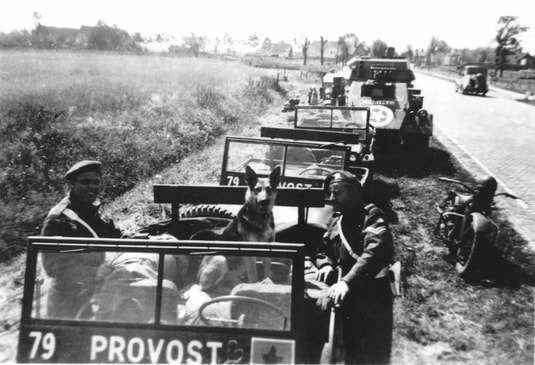Looking Back: Armoured Vehicles in the Canadian Provost Corps
By Lieutenant-Colonel Paul Thobo-Carlsen (Retired), CMPA Director of History & Heritage.
Since 1939, Canadian Provost and Military Police units have generally made do with light, soft-skinned vehicles to provide mobility during field operations—the motorcycle, Jeep, Iltis and G-Wagon being the most ubiquitous examples. During ISAF operations in Afghanistan, to help counter the ever-present ballistic and explosive threats, Canadian Military Police units did make limited use of RG-31 armoured patrol vehicles while conducting certain types of tactical operations. Presently, some Military Police field platoons are adopting the Canadian Army’s new Tactical Armoured Patrol Vehicle (TAPV). The TAPV will give our contemporary MPs a huge leap in protection and mobility during higher threat operations.
|
Interestingly, the first known use of armoured vehicles by Canadian Military Police was not in Afghanistan, but in Germany at the end of the Second World War. Details remain sparse about this short chapter in MP Branch history, but it is known that two types of light armoured vehicles considered surplus to combat arms requirements were made available to Canadian Provost Corps (CProC) units for duties in occupied territory after Germany’s unconditional surrender in May 1945.
In October 1944, Field Marshal Montgomery’s 21st Army Group (with included the First Canadian Army) requested that all “Fox” armoured cars in the United Kingdom be held in reserve for eventual internal security duties in North-West Europe. In fact, all 200 Foxes located in the UK at that time belonged to the Canadian Army.[1] The First Canadian Army made a request to Canadian Military Headquarters to release these and 100 “Otter” reconnaissance cars for such duties in liberated areas. While the plan changed several times in the following months, the use of light armoured vehicles in this role was deemed valid and, by March 1945, 100 Otters were called forward by First Canadian Army for security duties.[2] Some Fox armoured cars are also known to have to have been provided to CProC elements serving with the Canadian Army Occupations Force.[3] It is probable that only a relatively small number of these Fox and Otter armoured cars ultimately ended up in Canadian provost hands, the majority being used by other Canadian and allied units involved with internal security duties in occupied territory.
|
A number of CProC elements were involved in occupation duties from the unconditional surrender of German forces on 8 May 1945 until the Canadian Army Occupation Force (CAOF) was finally withdrawn in May 1946. The CAOF operated in North-East Germany and fell under the command of 21st Army Group. On 25 August 1945, 21st Army Group was renamed the British Army of the Rhine. It was responsible for the occupation and administration of the British Zone within a divided Germany.
|
The 2nd Canadian Infantry Division, supported by No. 2 Provost Company, conducted occupation duties in Germany for a short period until it was withdrawn to the Netherlands in early July 1945 and subsequently repatriated to Canada in October of that year. No. 11 Provost Coy (1st Canadian Corps) and No. 13 Provost Coy (2nd Canadian Corps), were also known to have conducted MP duties in occupied Germany during the May to June 1945 period. By 11 July 1945, the 3rd Canadian Infantry Division, supported by No. 4 Provost Coy, had taken over as the central formation of the CAOF.[7] At the cessation of hostilities, several Line of Communication (LoC) Provost Sections from the CProC were employed directly under Headquarters 21st Army Group. It is not clear for how long, or in what capacity, these Canadian LoC Provost elements continued to operate as HQ troops after May 1945.
|
|
The photos above and to the right show a group of Canadian provosts alongside a Military Police-marked Fox armoured car. The “79” unit signs and maple leaf formation signs on the jeeps suggest that they belong to No. 4 Provost Coy. The five-point allied recognition star on the Fox is painted off-angle in the common Canadian fashion to differentiate it from US-style markings (with the top point facing straight up). The fender marking "TC 1413" and right-leaning diagonal slash indicates that this Fox belonged to 21 Traffic Control Company. This unit had previously been part of the First Canadian Army, although it is believed to have been raised by the British CMP (Corps of Military Police).[8] It is unclear if this MP traffic unit remained under Canadian control within the 21st Army Group/BAOR (after the armistice) or if there was any inter-mixing of CProC pers in the crewing of its Foxes. Notwithstanding, the personnel and jeeps in these photos all clearly belong to the Canadian Provost Corps.
|
The Fox and Otter armoured vehicles allocated to Provost/MP elements in the CAOF likely proved very useful while conducting internal security duties in occupied territory. CProC duties in the immediate post-war period included the disarming, control and escort of large numbers of capitulated German troops, controlling the movement of numerous displaced persons (including those brought to Germany by force and employed a slave labourers—many of whom were quite ready to extract revenge on their former captors), helping with the control of German refugees, and otherwise assisting the allied military government in asserting law and order within the British Zone of occupation. However, this mission was a relatively short one. Plans for the CAOF's withdrawal began in January 1946 and by March of that year the last Canadian troops had left occupied Germany.[9]
Other than for this short period at the end of the Second World War, it does not appear that any other Canadian Provost Corps or Military Police units were provided with tactical armoured vehicles again until ISAF operations in Afghanistan when the RG-31 was briefly used. Now, with the incorporation of TAPVs into some Canadian Military Police field units, our contemporary MPs can claim a historical lineage to their armoured Provost predecessors from the 1945-46 period.
----------
Notes:
1. Report No. 141, Historical Section, Canadian Military Headquarters, Situation of the Canadian Military Forces Overseas: Progress of Equipment (January-December 1944), 18 July 1945.
2. Roger V. Lucy, The Otter Reconnaissance Car in Canadian Service (Ottawa: Service Publications, 2011).
3. Roger V. Lucy, The Fox Armoured Car in Canadian Service (Ottawa: Service Publications, 2014),
4. www.tanks-encyclopedia.com/ww2/canada/Otter_light_armoured_car.php
5. Lucy, Otter.
6. Lucy, Fox.
7. Report No. 174, Historical Section, Canadian Military Headquarters, The Canadian Army Occupation Force in Germany, May 1945 to June 1946, 25 March 1947.
8. United Kingdom, National Archives, WO 171/7785, 21 Traffic Control Company. The unit existed from January to October 1945.
9. Report No. 174, Historical Section, Canadian Military Headquarters, The Canadian Army Occupation Force in Germany, May 1945 to June 1946, 25 March 1947.
Notes:
1. Report No. 141, Historical Section, Canadian Military Headquarters, Situation of the Canadian Military Forces Overseas: Progress of Equipment (January-December 1944), 18 July 1945.
2. Roger V. Lucy, The Otter Reconnaissance Car in Canadian Service (Ottawa: Service Publications, 2011).
3. Roger V. Lucy, The Fox Armoured Car in Canadian Service (Ottawa: Service Publications, 2014),
4. www.tanks-encyclopedia.com/ww2/canada/Otter_light_armoured_car.php
5. Lucy, Otter.
6. Lucy, Fox.
7. Report No. 174, Historical Section, Canadian Military Headquarters, The Canadian Army Occupation Force in Germany, May 1945 to June 1946, 25 March 1947.
8. United Kingdom, National Archives, WO 171/7785, 21 Traffic Control Company. The unit existed from January to October 1945.
9. Report No. 174, Historical Section, Canadian Military Headquarters, The Canadian Army Occupation Force in Germany, May 1945 to June 1946, 25 March 1947.
